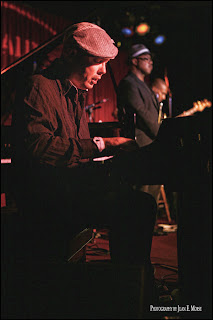Chris Colangelo;s “Elaine’s Song” 
C Note Records CNR 001 
Many weeks ago I started to listen to an album I received in the mail by West Coast bassist Chris Colangelo titled “Elaine’s Song” . Despite my unfamiliarity with his name or pedigree I was impressed by the musicians he had assembled for this date. The Cd is predominantly a compilation of the bassist's own
. Despite my unfamiliarity with his name or pedigree I was impressed by the musicians he had assembled for this date. The Cd is predominantly a compilation of the bassist's own
original compositions. With fellow West Coast artists like Bob Sheppard on saxophones, John Beasley on piano and Steve Hass on drums, each accomplished musicians in their own right, I was looking forward to my maiden voyage with bassist Colangelo and his music. This west coast excursion did not disappoint. After a few satisfying listens, I put the album aside with every intention of writing a review. I was impressed with Bob Shepard’s playing on this album, so much so that I made a point of trying to see this veteran saxophonist ,a hidden but in demand voice on many a studio session, at the venerable Van Nuys jazz watering hole Charlie O’s , while I was out visiting my daughter in LA several weeks ago
Sadly Sheppard did not perform as scheduled, but we did get to see another local talent, the saxophonist Chuck Manning. Things subsequently got hectic and several reviews and live performances later, I realized that I never got around to reviewing Colangelo’s fine album.
From the start of this Cd you can hear the solid compositional acumen of Colangelo. Despite the predominantly original format, most of the songs resonate like they have always belonged to the jazz lexicon.
The entire album is as good a representation of the best in contemporary jazz as you will find, with fine ensemble playing throughout. Saxophonist Sheppard, whose a first call studio musician, gives a notable performance on the opener “ The Ubiquitous One” where he plays with a warm, precise tone that slithers through the chicane-like changes effortlessly, John Beasley’s piano solo is tasteful at every turn. Colangelo’s bass is full toned and round and Hass’s drums are taught and punctuate the breaks nicely.
O the steamy “Like Kenny”, dedicated to one of Colangelo’s favorite saxophonists, Kenny Garrett, altoist Zane Musa steals the show with a fabulously rambunctious burst of pure spontaneous combustion. I will be watching out for more of this guy.
The group cooks on this post bop vamp, with Colangelo’s full walking bass lines anchoring the driving rhythm. Hass adds a series of rolling tom crashes and a polyrhythmic solo as saxophonists Clatsworthy and Musa trade licks with Beasley and each other, ending in a splendidly crisp finale.
The title song, “ Elaine’s Song” , is dedicated to Colangelo’s wife and features some of this fine player’s solo bass lines. He has a round, generous tone that is warm, precise and inventive. Beasley is effective as Colangelo’s foil , keeping his comping light but brilliantly sympathetic. Shepard is particularly mellifluous and lyrical here.
On “Green and Blue” flautist Benn Clatworthy is featured in a clever take off the Evans/Davis classic.
His Dolphy like sound has a hauntingly eerie quality. Pianist Beasley is superbly tasteful here and once again proves to work extremely well with Colangelo as the composer solos on bass.
The straight-ahead “Gryffindor’s Revenge” will please anyone who appreciates a tight piano trio with truly in-sync musicians of such high caliber as Colangelo, Hass and Beasley.
“Watts Important” is a dedication to drummer Jeff “Tain” Watts .
Colangelo deftly performs bassist Steve Swallow’s elegant “Falling Grace” with pensive, resonating notes at the intro. Throughout the thoughtful piece, Beasley and Colangelo show a telepathic interchange of ideas that is both prodding and sympathetic, while Hass skillfully weaves his percussive sounds around them. Beasley performs his most expansive solo of the album here and it is jaggedly beautiful. Colangelo shows his most dexterous side as he solos with a fluid grace
towards the last quarter of the song.
John Coltrane’s “Straight Street” features Bob Sheppard on a wonderfully buoyant soprano saxophone. The versatile Sheppard has an affinity for playing this sinewy sounding instrument with joyful ease on this breathless solo.
Colangelo saves a real gem for his closer, the evocative “From Dark to Light”. Drummer Hass predominantly plays cymbals here as Beasley tickles out the barest of comps from his ivories over Sheppard’s brooding tenor. Colangelo offers fat, lingering Haden-like bass lines perfectly placed behind Haas’s beat. Beasley again offers a penetrating solo that seems to wander leading you in a contorted direction, but somehow getting you back to a satisfying conclusion. He incorporates some Latin inspired chording intermingles with some classically tinged flourishes for good measure. When it is Sheppard’s turn to solo, he is appropriately restrained, but subtly builds and releases tension in an almost stealth-like way. Colangelo finishes with a plucky bass solo, setting up the band as they bring the repeating closing refrain to a beautifully executed climax; very satisfying indeed.
Recorded: Umbrella Music Studio, Chatsworth, CA
Musicians: Chris Colangelo (acoustic bass); John Beasley (piano); Steve Hass (drums) ; Bob Sheppard (tenor on tracks 1, 3 & 9& soprano saxophone track 8); Benn Clatworthy (tenor sax on tracks 2 & 6, flute on track 4); Zane Musa (alto sax on track 8)
























